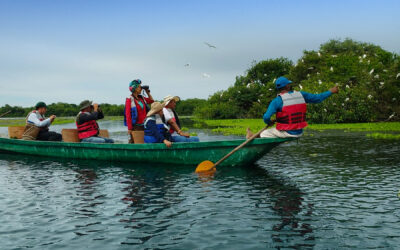Welcome to today’s blog!
Minca, a district within Santa Marta, is a land of remarkable diversity, encompassing 18 distinct villages stretching from the coastal zone to the sub-paramo highlands. A walk through its streets unveils a dramatic shift in altitude within a few meters, transitioning from warm, coastal weather to the refreshing coolness of the highlands. This transition mirrors the changing tapestry of vegetation, evolving from tropical dry forests to lush tropical rainforests. Here, nature thrives, boasting an incredible richness of species, from elusive footprints to the enchanting songs of the wild. However, when seeking scientific information about this ecological treasure, you may find yourself hitting a dead end. Behind these mountains lies an untold history that has, until recently, discouraged academia from exploring its riches.
Prior to 2010, Minca was a place feared by Santa Marta residents due to a history marked by violence. The 1970s saw the arrival of armed groups in this area. The ELN took control in 1975, followed by the FARC in 1990, and then the paramilitaries in 2000. These events led to the forced displacement of local peasants and indigenous communities to the capital city. After 2007, only a handful of people had the courage to return to their homes, as many families preferred to stay away.

The need to promote studies in Minca through SCIENTIFIC TOURISM arises from the area’s unique biodiversity and the transformations in land use and vegetation cover that have occurred since pre-colonial times. The Betomas Indians, descendants of the Kaggaba (Kogui language), Arhuaco, Wiwas, and Kankuamos, chose Minca as a site for festivals, ceremonies, and sacred payments. Little has been documented about their major transformations, but it was considered a resting point for those on their way to Santa Marta and the Ciénaga Grande de Santa Marta from Ciudad Perdida.
During the colonial period, the Spaniards introduced sugar cane and coffee cultivation to the Minca estate, owned by Joaquín de Mier y Benitez, who also hosted Simón Bolívar on his deathbed at the Quinta de San Pedro Alejandrino. Some Minca residents recall that parts of this estate were once sites of indigenous torture by the Spaniards and favored spots for treasure hunters seeking indigenous riches.

In the 1970s, the period of violence saw the transformation of forests into marijuana plantations. The 2000s brought deforestation with the arrival of paramilitaries and coca cultivation, leading to the spraying of glyphosate in forests, streams, and farmers’ crops. Glyphosate left lasting marks on the soil, hampering its productivity. Today, Minca faces increased deforestation driven by tourism and the division of land inherited by the children and grandchildren of early 20th-century workers. Foreign tourists purchase pieces of land for cabins and engage in tourism and agriculture without proper state planning. This has increased water demand, reduced forest cover, and transformed Minca into a melting pot of European and American foreigners, indigenous people, city-dwellers, and descendants of local peasants.

In recent years, initiatives have emerged for the conservation of biodiversity in Minca. One example is the project for the conservation of the white-faced corn monkey Cebus malitiosus, led by Juliana Cortes and Diana Guzman of the Primatological Association of Colombia in 2019. A second phase, titled “Nature Tourism as a Fight Against Deforestation,” was launched by the Swisscontact Foundation and coordinated by myself. These efforts gave birth to the COLECTIVO CIENSIERRA, a collective of 13 peasant families, each with their property. Together, they have united to safeguard Minca’s forests through scientific tourism, capturing images of the region’s biodiversity and gaining the attention of national authorities focused on fauna and flora conservation.
EcoEncounter aims to strengthen this collective, positioning Minca as a national and international academic destination for the dissemination of scientific information. We aspire to attract universities and researchers who can leverage the services offered by COLECTIVO CIENSIERRA for their research objectives, contributing to informed decision-making for the planning and conservation of Minca’s forests. Moreover, we seek to pass on this knowledge to the next generations of the region, fostering a renewed commitment to preserving Minca’s natural treasures.



